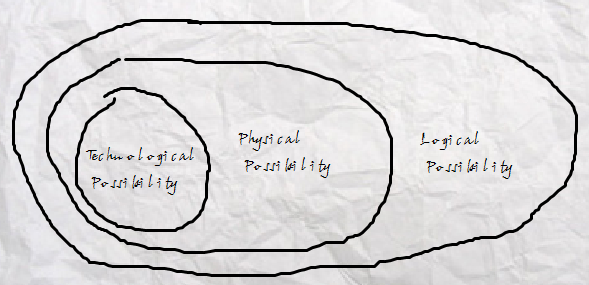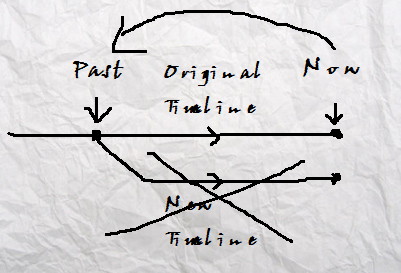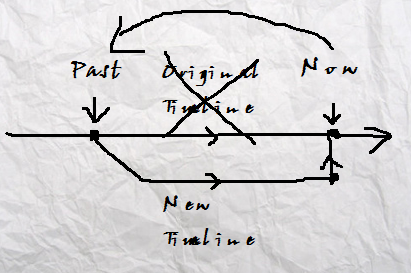search the site
Time Traveling to the Past

Red telephone box on the Oak Ridges Moraine in Ontario, Canada
Time Traveling to the Past
Chi Wai Law, The Hong Kong Polytechnic University
ABSTRACT
Time travelling is often one of the elements in countless science fiction novels and films around the world. The dialogue in this article starts with two speakers who want to patronize the already closed café by using a time machine. They discuss the possibility of time traveling and how it can be achieved in theory. Meanwhile, a classic film ‘Back to the Future’ is proposed as an example when they are talking. The speakers raise some fascinating questions, such as saving one’s life, that come into conflict with logic when someone travels into the past. Additionally, the concept of timeline is introduced in order to provide a transparent idea showing how the histories change. This article intends to motivate readers to think logically in this topic.
Keywords: Consciousness, past, philosophy, technology, time traveling
Akito and Eric are best friends. They are discussing where to go for high tea.
Akito: Hey! Let’s go to the famous, old café near the campus. I’m so hungry after the three-hour lecture.
Eric: Is that the one beside the book store? It closed down three days ago!
(They are very disappointed and subsequently sit down at the library)
Akito: I’m so unhappy. I’ve never tried the delicious coffee there. I wish I had noticed that.
Eric: So am I. But wait…We could try that or even stop its closure, if we had a time machine!
Akito: Come on, time traveling is merely one of the plots in novels and the movie world. It’s impossible in reality, because our technology isn’t there yet.
Eric: Maybe it’s not practical today, but you can’t deny the possibility of making a time machine someday in future.
Akito: Why?
Eric: Throughout history, things that were thought to be impossible have been invented.
Akito: Any examples?
Eric: Sure. Give me a piece of paper first and let me explain it with the aid of a diagram.
Akito: Here it is.
(Eric drawing)
Eric: For example, humans couldn’t fly before the Wright brothers had improved the technology of flying machines, right? That means, in the 19 century it wasn’t technically possible, even though it was physically possible. Somehow, it should be logically possible. Similarly, the invention of time machines isn’t achievable now. But it is physically possible and logically possible if there weren’t any contradictions against physical laws and logic. Therefore, in the future, it could be created because of our improvement in technology. I got this idea from a book written by Jack Chun.
Akito: Do you mean that time traveling could work in the future if it didn’t have any logical problems?
Eric: I don’t know, but at least it is possible if we can deal with it. First, we need to recognize the characteristics of time. Do you have any idea about this?
Akito: Give me some time to think about it. (After a few seconds) Um, I reckon time is like a frame passing over us. And one frame may be a second and the unit of time is defined by us rather than by nature. We can’t see and hide from time flow as well.
Eric: That’s true. But I prefer Chun’s point of view that when we experience the flow of time, it’s the flow of our consciousness that we experience. As our consciousness exists inside the brain, we can explore the past time flow or even stop feeling the time flow. So, philosophers have often discussed the physical movement of our bodies but not our consciousness.
Akito: (frustrating) Wait! I am confused. You just talked about time’s characteristics and the possibility of time travel. Can you just explain the relationship between them?
Eric: Oh, sorry. Let me use a timeline to talk about it. Starting with a movie called “Back to the Future”.
Akito: (exciting) I’ve watched this movie! In the first scene of the movie, Marty’s friend Doc is killed by gangsters when they are testing a time machine made from a racing car. To save his life, Marty goes back to the past to prevent the tragedy. Marty is transported to a time when his parents hadn’t met each other.
Eric: You really know the plot. As the story moves on, Marty’s teenaged mother almost fell in love with him. If his mother hadn’t loved his father and then married him, Marty wouldn’t have existed in the future! This is the logical problem that I mentioned.
Akito: I think in this case, one straight time line is not able to solve the contradiction.
Eric: I can help you solve this problem. The author introduces the model of branching timelines. Let me analyse this. (Pointing at the paper)Look at the timeline here. When Marty arrived at the past, a new branch of the timeline appeared at the same time. He, the time traveller, exists on the new time line but not the original time line because he hadn’t been born.
(Eric drawing)
Akito: According to your explanation, the original time line and Marty will disappear because a new time line has been established.
Eric: That’s correct but not in this movie.
Akito: What does that mean?
Eric: Do you remember the plot at the end of story?
Akito: Of course, I’ve watched this movie three times! After Marty made a match between his father and mother, he was going to leave. Marty wrote down the details of how Doc will be killed in a letter and put it inside his overcoat. Unfortunately, Doc found it and tore up the letter because he didn’t care about it. When Marty goes back to the future, he sees a series of incidents that happen exactly like “before” – Doc is killed by gangsters, Marty drives the time machine and they leave.
Akito: And at the end, Doc is still alive! He combines all the small pieces of letter and gets all the information about the incident. He puts a metal board under his clothes and protects himself shooting by the gangsters.
(Eric drawing)
Eric: This implies that at the beginning of the story, Doc doesn’t die because the past Marty reminds him. Marty seemingly saves Doc’s life. This is because history doesn’t change even though he goes to the past. So, the time flow continues in its original direction. This surprises me a lot. Here, a question arises – What if Doc actually dies?
Akito: (Akito shaking his head) I don’t know!
Eric: Let me draw another diagram to explain it.
(Eric drawing)
Eric: The idea of branching of time wasn’t clearly mentioned in the movie. An action that happened can’t be changed. This time, Marty goes back and saves Doc’s life. However, the one he saved is on the new timeline but not on the original timeline. The main point is that when you choose to use a time machine to go back in history, you already forgo the original timeline. The time traveller can ignore the history of the original timeline, such that Marty can exist even though “he” wasn’t born on the new timeline at that time.
Akito: That means we can go back and try the dessert and coffee in the closed café. In this case, I don’t mind to forgo this timeline to enjoy them both!
Eric: Don’t think that’s not important! Let me explain…
Akito: (Put his hand on Eric’s month) Stop! Tell me after I’m full up.
BIBLIOGRAPHY
Chun, J. (2011). Being philosophical: Invitation to philosophical thinking. HK: McGraw-Hill Education.
Gale, B., & Canton, N. (Producers), & Zemeckis, R. (Director). (1985). Back to the future [Motion picture]. United States: Amblin Entertainment.
ASSIGNMENT SUMMARY
This article is an assignment related to a course inviting students to express their ideas in dialogue form.
ABOUT THE AUHTOR
Law Chi Wai is a senior student at The Hong Kong Polytechnic University majoring in Environmental and Sustainable Development.


















